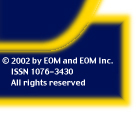| So... What is AFE/ATR?
By William T. Sharp Overview
Those who are familiar with the National Imagery and Mapping Agency (NIMA) and the Pathfinder process that takes place each year are probably familiar with what AFE/ATR is all about. So, for those of you too busy to keep up with the Pathfinder evaluations, or simply unfamiliar with the process, here is some information that should provide some insight.
First things first, what is AFE/ATR? The answer is "Automated Feature Extraction" and "Assisted Target Recognition." These were technology areas in the NIMA Pathfinder 2000 technical crosswalk evaluations. Beginning as Project Beacon (1995), and continuing under the Pathfinder projects for 1996, 1997, 1998, and 1999, the results of Pathfinder 2000 provide an important link between the user community and commercial and government developers of technologies.
Beacon (1995) defined the analyst processes and identified technology areas holding the most promise for meeting imagery analyst (IA) needs for softcopy search.
Pathfinder '96 developed specific recommendations for infusing imagery exploitation tools into IA environments.
Pathfinder '97 recommended tools capable of manipulating geospatial and imagery intelligence information and supporting the downgrading and declassification of imagery products.
Pathfinder '98 identified "geospatial tools" to integrate imagery intelligence and geospatial information, and to support information applications for the Geospatial Information Infrastructure (GII).
Pathfinder '99 investigated scene visualization (SV) hardware and software, which serve as primary tools for combining terrain and surface information (rendered scenes) with the aim of providing a full 3D view that approximates the real world as closely as possible.
Pathfinder 2000 AFE/ATR examined tools that would support the extraction of features and objects of interest. The team assessed the availability and suitability of various software tools, their ability to support exploitation operations (including interoperations), and their ability to help organizations better accomplish their missions and support customers. This investigation and assessment of a wide variety of tools greatly enhances NIMA's goal of promoting geospatial technology research, development, applications and programs. The Process
The Pathfinder process identifies, assesses, and recommends tools and technologies to help imagery and geospatial information analysts and the users of the United States Imagery and Geospatial Information Services (USIGS) to better exploit the increasing amounts and sources of imagery, and to better serve a demanding and expanding customer population.
Pathfinder 2000 followed the DoD directives for acquisition of commercial and nondevelopmental items, and contacted more than 300 vendors and developers of tools potentially useful for AFE and ATR. Vendors and developers nominated 61 tools for inclusion in the process, and they formally submitted 41 tools for the Pathfinder evaluation process. There were 20 tools that either did not qualify or were not formally submitted. Subject Matter Experts evaluated 32 of those in the Functional Crosswalks, and selected the 16 tools showing the most potential for benefit to their exploitation processes. The Results
The NIMA Pathfinder 2000 AFE/ATR evaluated several COTS remote sensing software packages. ENVI, the Environment for Visualizing Images, was included in this evaluation for the first time, and the results are now available in the NIMA Pathfinder 2000 report. Having passed rigorous testing and evaluation, ENVI was rated as one of several top tools.
ENVI's strengths, as related to the key evaluation categories, are described below.
Ingestion and Preparation-ENVI has extensive support for image and GIS formats of interest to the NIMA user community. This includes support for NITF, CIB, ADRG, DTED, and various other satellite-and aircraft-based high-resolution panchromatic, multi-spectral and hyper-spectral imagery. In addition, ENVI also supports ArcView, ARC/INFO, Intergraph and Autocad formats.
Exploitation-ENVI is recognized by industry, government and academia as the leader in hyperspectral data analysis. ENVI has the most advanced tools for visualizing and extracting features and targets from hyperspectral data, and has been recognized as such by NIMA. Also, ENVI is not only for hyperspectral analysis; the advanced analysis capabilities in this software can easily be applied to multi-spectral and high-resolution panchromatic data.
Manipulation-ENVI algorithms and processes are built on rigorous scientific research. This ensures that the deterministic analysis and attribution of features is accurate, which is an important consideration for mission-critical operations.
Dissemination-ENVI provides tools for 3D visualization, cartographic map output, as well dissemination to web-ready formats.
Human-Computer Interaction-ENVI combines advanced features with ease of use by including an intuitive graphical user interface. Pathfinder 2000 Recommendations
The purpose of the Pathfinder 2000 AFE/ATR project was to recommend tools to support Automated Feature Extraction and Assisted Target Recognition. The project's recommendations were as follows:
¥ Users should consider the results in the Pathfinder 2000 AFE/ATR Technical Crosswalks Results Chart when acquiring tools to enhance any step in the process of Automated Feature Extraction and Assisted Target Recognition
¥ Readers also are cautioned to verify the vendor data due to the rapid rate of technology change, and to contact the vendor to obtain updated data
¥ Users should consider a mixture of tools to satisfy AFE/ATR exploitation needs, if one tool is not sufficient in its own right
¥ The Pathfinder Team should disseminate the results to the SMEs and vendor/developers who participated, as well as to members of the ATRWG, the CRADA and MERIT Program Managers, and other users of AFE/ATR
ENVI is marketed by Research Systems and is developed using IDL, the Interactive Data Language, by prominent researchers in the remote sensing and hyperspectral analysis at BSC, LLC.
For additional information, please see the NIMA Technology Assessment home page at www.nima.mil/TAT/tat_home.html About the Author:
William Sharp has been a part of the remote sensing and GIS industry for over 14 years. With a background in geophysics and remote sensing, he has many years of experience as a remote sensing theory-and-applications instructor, marketer, and software product development manager. He has intimate knowledge of various remote sensing application areas. Mr. Sharp currently manages the development and marketing of ENVI for Research Systems in Boulder, Colo. He can be contacted at (303) 786-9900, or via e-mail at [email protected] Back |




